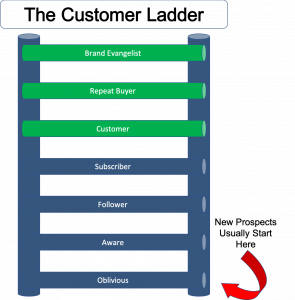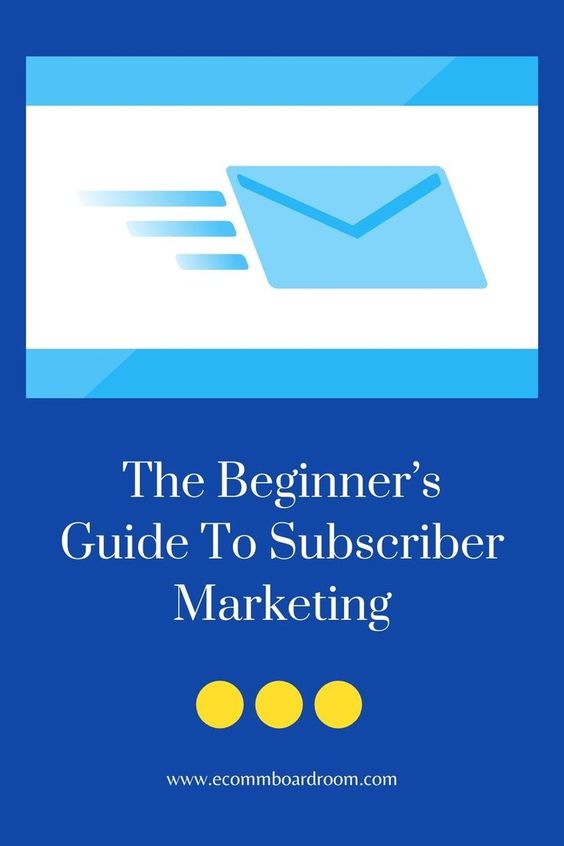Welcome! This is the FINAL PART of a 3 part series in which I’ve been discussing the three components of a Systematic Marketing Strategy. Part 3 covers Subscriber Marketing.
To review…
3 Components of a Systematic Marketing Strategy:
- Outbound Marketing
- Inbound Marketing
- Subscriber Marketing
Up to this point, we have discussed how both Inbound and Outbound Marketing strategies serve to convince our ideal prospects to become customers.
Short of that, our secondary goal for Inbound/Outbound is to convince them to become a Subscriber.
What is Subscriber Marketing?
Subscriber Marketing encompasses every piece of content you send to someone that volunteers to receive messages from you.
The ultimate purpose of Subscriber Marketing is to convert subscribers into customers, and to convert customers into repeat customers.
What is a Subscriber and who cares anyway?
A subscriber is someone who volunteers to receive messages from your brand. For the most part, this takes the form of either:
- A social media follow, or
- Signing up for your email list.
Of the two, the email address is most valuable.
That’s because people tend to think of their inbox a bit differently than posts they see on social media. The inbox is an intimate place. Each email is regarded with greater importance than each post (in part, because we all follow so many frivolous accounts on social media). As such:
You are more likely to convert an Email Subscriber into a customer than a Social Media follower.
In either case, you are one step closer to earning a customer when you gain a subscriber. That’s because once you have a subscriber (or a follower), you can send them messages for FREE, as often as you want.
The Customer Ladder
To explore this idea, imagine that your ideal prospect is climbing a ladder. Throughout the climb, they might step on all, some, or just one of the rungs of the “Customer Ladder”:

The Rungs of the Customer Ladder
- Never Heard of Your Brand (Oblivious)
- Heard of You, Don’t Pay Much Attention to You (Aware)
- Follow You on Social Media (Follower)
- On Your Email List (Subscriber)
- Made a Purchase (Customer)
- Made a Second, Third, Fourth Purchase (Repeat Buyer)
- Told My Friends About You (Brand Evangelist)
Your goal is to help people ascend from #1 to #7.
Someone might jump immediately from Oblivious to Customer. They might go from Aware to Subscriber, and never become a Customer. An individual may go one rung at a time, straight up the list from Oblivious to Brand Evangelist. Or any other combination you can think of!
But this is the point. If you can master the tactics for ascending a prospect up the Customer Ladder, you will create a pipeline of reliable, profitable business.
Social Media Follower Marketing: Convert to Email
Let’s recap. We know subscriber marketing is important. You can send your followers and subscribers unlimited messages for free. With those messages, you can convince them to ascend the customer ladder, and eventually, become a customer.
Through this lens, the goal of Social Media Follower Marketing is to push your followers up the ladder. That means converting them to a customer or a subscriber. The latter will be much easier.
Your primary goal in Social Media Follower Marketing is to convert followers into email subscribers.
Social Media Profile Setup and Landing Pages
In the Inbound Marketing article, we discussed how setting up your Social Media Profile is key.
To recap, set up your social media profile in the following way:
- Include a description about your brand’s primary value proposition.
- Succinctly state the biggest problems you solve for your customers.
- Provide a link to your website’s best Landing Page.
Design the landing page that you link from your social media profile to capture a prospect’s email address.
This is the process:
- A Social Media follower regularly enjoys the content you post.
- One day, they get curious, and click to your profile.
- They see the description of the value that your brand provides. “Hmm! That’s interesting,” they say to themselves.
- They click the link in your profile and navigate to your landing page. They give you their email address in exchange for your lead magnet.
A lead magnet is a high-value piece of content offered for FREE in exchange for your prospect’s email address.
For example, if you are selling Garlic Presses, you could offer a free list: “Cooking with Garlic: Top 15 Healthy Recipes”. More on lead magnets in the next section.
Using the strategies outlined in the Inbound Marketing article, drive people to your landing pages via your social media profile.
And focus on ascending them up the Customer Ladder.
Email Marketing: The Highest ROI in All of Digital Marketing
I can’t stress enough the importance and value of Email Marketing.
Building a “List” of email addresses should be one of the primary goals of your business. Again, you can email your list for FREE as often as you want.
The first step is to learn how to grow your list.
Then, become proficient at creating great email offers. Once you do, a percentage of your list will make a purchase every time you send an email.
Growing Your List: Lead Magnets
Lead Magnets are the key to growing your email list.
Again, a Lead Magnet is any mechanism that is used to capture the email address of a website visitor.
Without a doubt, the most effective format of a lead magnet is the popup form.
Many entrepreneurs have a natural aversion to popup forms. They perceive them to be annoying. However, the reality is that they just work.
I grew my email list from 300 to 3,000 in about 6 weeks after implementing a simple popup form on one of my sites…
So don’t fear! Embrace the popup!
Lead Magnet Examples and Implementation Best Practices
For any lead magnet to work, there must be a compelling reason for the visitor to part with their email address.
That is, you have to provide something valuable in exchange for an invitation to appear in their inbox.
Examples of good lead magnets include:
- Free eBook
- Discount Code on First Purchase
- Free Report or “How-To” Guide
- Product Catalogue / Price Sheet (for B2B and high-ticket)
- Free Shipping Deal
- The Promise of Exclusive Promotions
- Exclusive weekly newsletter
- Free Templates / Tools (For Information Products & Coaching Businesses)
Think critically about your market and products. Brainstorm what information, tools, or financial offerings would pique the interest of your potential customers.
After you create the content, use a mix of the following formats for your lead magnets:
- Popup forms
- Landing pages
- Embedded header, footer, and sidebar forms
Last but not least: test.
It is extremely important to mix up your strategies in a methodical way, measure the results, and double down on the ones that work.
Depending on your industry, you might even run ads to a landing page where you do nothing but capture email addresses.
If you can calculate that an email address is worth $X to you, and you can acquire an email address (through advertising) for less than $X, this strategy makes sense!
Mailing Your List: Best Practices
Growing your email list is important, but it serves a higher goal: To convert Subscribers into Customers.
It’s all about continuing to ascend your prospects up the Customer Ladder.
Once you have employed brilliant lead magnets on your site and are growing your list, you will of course need to…well, send them emails!
The majority of the following strategies are taken from my personal experience as well as Matthew Paulson’s excellent book: Email Marketing: Demystified.
Getting Started: The Autoresponder Series
When a Subscriber first joins your list, they should enter into what is known as an Autoresponder (or Welcome) Series. This automatic sequence of emails introduces your new subscriber to your brand and establishes a personal connection. Over the course of 1-3 months, send them 2-3 emails per week.
The Autoresponder Series should include a healthy mix of the following types of emails:
- Your Company “Origin Story”: This is an “About Us” email or series of emails, but remember: the customer should still be the focus! Go back to StoryBranding.
- Educational Content: provide your customer with tips, “how-to’s”, and answers to FAQs. This will keep them engaged and interested, and establishes you as an authority figure in your space.
- Product Offerings & Sales Funnels: Yes, you should provide links to your product pages in your Autoresponder Series! Just don’t do it every day or you will come off spammy.
- Links to Your Blog: Has the same effect as Educational Content. Encourage them to share your posts with their friends, so you can continue to grow your subscriber list.
- Surveys: Nothing gets your customers engaged quite like asking for feedback. Survey your customers about what they are interested in and tailor your content, products, and services to their responses.
Yes, it will require some up front work to create your autoresponder series. But it will pay off big time in the long run.
Other Email Marketing Best Practices
After customers exit the autoresponder series, you should still be emailing them at least twice per week.
Sales & Value Email Balance
As already mentioned, you should not attempt to sell a product in every email. Let’s call these Sales Emails.
Value Emails, on the other hand, include all the educational content, surveys, blog posts, etc. that we discuss in the last section.
As a good rule of thumb, try to provide 2-3 Value Emails for every 1 Sales Email that you send.
Email Copy Best Practices
In terms of the actual content of your emails, the “Email Copy”, there are two primary components: The Subject and the Body.
The Subject line, and closely related preview text, are extremely important because they are the ‘elevator pitch’ for that email.
The subject is the primary thing your subscriber will use to determine whether or not they are going to open what you’ve sent them.
So get good at using compelling, attention grabbing, curiosity invoking, or funny subject lines.
After you’ve written a great subject line, move on to the Body.
Data shows that the Body of your email should be written in a personalized format to get the best engagement with your audience.
Treat your emails as though you are writing them ONLY to a SINGLE ONE of your ideal customers, and not a huge list of people. Address it to your Profiled Ideal Customer.
Sales Emails: The AIDA Method
Finally, for sales emails, consider the AIDA method for selling products. AIDA stands for:
- Attention: Use the Subject to capture their attention. Tell a story, make a joke, or give an interesting statistic in the first couple of sentences of the Body.
- Interest: Make an analogy between your attention-grabbing intro and your product or service.
- Desire: Paint a picture of the negative emotions associated with the problem. Depict the positive emotions that your product can create by solving it.
- Action: Give a clear CTA. “Click Here to Purchase”.
Master the methods of building, nurturing, and providing value to your Subscriber List, and you will be able to extract that value 10x from your List and build a formidable eCommerce brand.
Wrap It Up, Chuck
And that concludes the three part series on a Systematic Marketing Strategy.
Hopefully you see how Outbound Marketing, Inbound Marketing, and Subscriber Marketing work together to bring your ideal prospects into your business and ascend them up the customer ladder.
I know these articles were dense! If you have any questions, reach out at: info@ecommboardroom.com.
And if you enjoyed this series, please consider signing up for our email newsletter through the form below. In it, we provide awesome insider tips to help you start and grow your eCommerce business. Thanks for reading!


